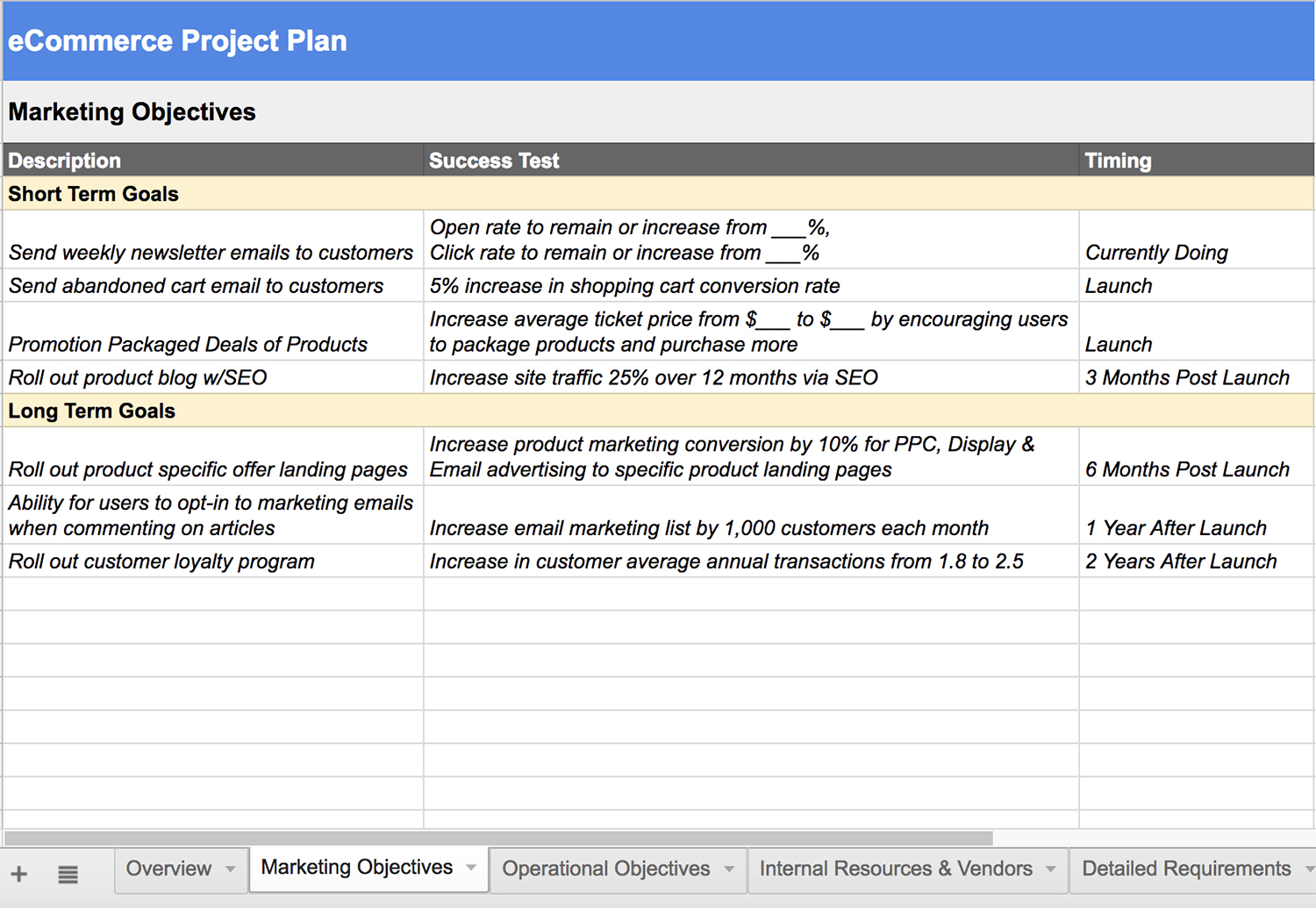Seven Keys to a Successful eCommerce Launch: Key Two – Marketing Objectives

DITOR’S NOTE: This blog post is the second in a continuing series. If you’re considering an eCommerce project at your company, you’ll want to watch this space. The posts in this series – and the link to resources at the end of each post – will help you complete some vital groundwork and address important questions that will save you time, work, and money. We hope you enjoy them and find them useful.
In the first blog post of this series, we focused on the importance of planning your eCommerce project and laying a solid foundation for everything that comes after. Now it’s time to turn our attention to marketing objectives: Addressing and identifying them is the second key to eCommerce success.
When we talk about marketing objectives, we’re including four separate subjects:
- Short-term marketing goals
- Long-term marketing goals
- Measurable goals and key performance indicators (KPIs)
- Planning for growth
Just as we did in the first blog post, let’s address these areas by asking some important questions.
Question 1. What are your short-term marketing goals?
There are many things to consider here, including:
Audience – Perhaps you want to grow your demographic over the next few months. Maybe you want to build a strong social media presence. You might want to do a better job with increasing your customer retention. Your short-term marketing goals might include all three of these tasks as well as other objectives.
Commerce – Yes, it sounds a little obvious. Your eCommerce launch is all about commerce, of course. But what kind? Specifically, are you looking to boost your company’s sales through this channel? What about using eCommerce to liquidate your older inventory? Have you thought about harnessing the power of eCommerce to create a selling frenzy? And don’t forget how easy this channel makes it to initiate flash marketing campaigns. All of these are great examples of commerce-related marketing objectives for you to consider in the immediate future.
Search engine optimization (SEO) – Here’s another area to consider when you’re discussing your short-term marketing goals. This is the perfect time to think about how you want to improve your company’s placement in the major search engines. You’ll also want to set goals for directly engaging your customers. The short term is also the right place to begin strategizing about how you’ll grow brand awareness of your company and products from the local to the national level.
Question 2. What are your long-term marketing goals?
Now that you’ve identified what you want to accomplish in the immediate future, it’s time to think about longer-term objectives. As you do that, you might find it helpful to keep these action-oriented words in mind:
Grow – Cultivating overall sales efforts, driving more and more customers online, and increasing average ticket orders are all growth-related long-term marketing tasks.
Broaden – Selling is the lifeblood of your business. If nobody is purchasing your products, then you won’t be around very long. But have you considered broadening those sales by improving the attachment rate of other products? This is a critical long-term marketing activity that will result in valuable secondary sales.
Expand – You already know who your primary audience is. After all, that’s why you went into business in the first place. But what about expanding that vision and developing a new audience? Promotional and social marketing avenues can be wonderfully effective ways to accomplish this kind of long-term marketing goal.
Question 3. How will you measure your goals and define your KPIs?
Okay, technically those are two questions, but they’re so closely related that we’re combining them here. It’s all well and good to have a goal, but it doesn’t mean a thing if it’s not specific, measurable, and time-oriented. Luckily, we’ve started answering Question 3 for you.
Remember our free eCommerce Planning Template that you used to establish your eCommerce planning framework at the end of the first blog post in this series? You’ll want to have it handy now, because this is what you’ll use to establish your KPIs or success tests.

Go to Tab 2 (titled “Marketing Objectives”) in the document. Enter your company’s short- and long-term marketing goals here. Be as specific as you can in describing them. Next, determine your success test (your KPI) for each one of those goals. Again, quantify exactly what constitutes success to you; use concrete numbers, dollar amounts, and percentages.
Finally, determine the timing for every single goal you’ve included in the planning template. In this column, note whether you are currently working on the activity or exactly when it will be taking place (e.g., during your eCommerce launch, three months post-launch, six months post-launch, etc.). Remember to save the document because you’ll be going back to it in subsequent blog posts.
Question 4. How will you plan for your future growth?
We like to tell our clients, “Build for today and plan for tomorrow.” (There’s that “planning” word again that we talked about so much in our first blog post!) Think in terms of your one-, three-, and five-year goals. Yes, you may very well tweak, revise, add to, or even replace those longer-term goals as the years unfold, and that’s all right. All you really need to accomplish any goal is a good decision and a solid plan. Don’t overthink it – just get started on the journey.
Stay tuned for the third post in this series: Operational Objectives. In the meantime, please share your comments and questions about this blog post with us!
Resource Center

A new blog series about the critical eCommerce capabilities missing in most eCommerce platforms for B2B companies. #1: Quoting & Sales Support

A closer look from the Ultra perspective on what we really mean when we talk about headless commerce and why it may not be right for every company.

Davis Art is now the only online K-12 publisher dedicated to the arts, creating top-notch curriculum and resources for art educators nationwide, all from the Ultra Commerce platform.
